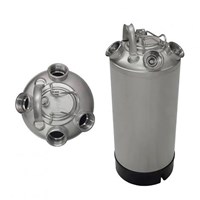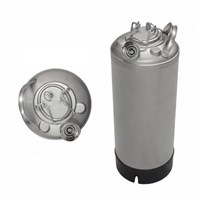AEB Kegs - Ball Lock Corny Kegs
For over 20 years AEB Kegs has been a world leader in the production of stainless steel containers for the beverage industry, AEB specializes in:
- Reliabity in production, quality and the running of all related services.
- Flexibility in responding to promptly to each specific segment of the beverage industry, soft drinks beer and wine.
- Experience to understand customers requirements and to be able to interpret each request in a very positive way.
- High quality, stainless steel ball lock corny kegs.
AEB Kegs constantly strives to improve on already excellent quality standards and be responsive to the future requirements of the market.
It is AEB Kegs goal to continue to supply the worlds leading soft-drink bottlers and breweries with our excellent range of industry standard and bespoke products. AEB Kegs has recently moved to a new production facility, which involved and upgrade to the latest manufacturing equipment and processes. The continued investments in development, technology and manufacture will enable AEB Kegs to maintain our lead in the market.
Sanke Beer Kegs » Cleaning Kegs

Part# SC-5G-4
$479.99 $429.95

Part# SC-5G
$289.99 $249.95
The Importance of Cleaning Kegs for Draft Line Cleanliness
Cleaning kegs play a pivotal role in ensuring the cleanliness and quality of beverage lines in the beverage industry, including breweries and bars. These specialized kegs are designed to clean and sanitize beverage lines, removing any residues, contaminants, or flavors from previous use. Here's how they work:
How Cleaning Kegs Work
- Remove Lid: Cleaning kegs have an easy to remove lid so that the keg can be filled with cleaner, sanitizer or rinse water.
- Cleaning Solution: A cleaning solution, typically a blend of water and specialized cleaning agents, is prepared.
- Keg Filling: The cleaning solution is added to the cleaning keg.
- Keg Insertion: The cleaning keg is connected to the draft beverage system through the keg's valve.
- Circulation: The cleaning solution is pumped from the keg, thoroughly cleaning, sanitizing or rinsing the length of attached beverage line.
- Rinsing: After cleaning, the cleaning keg is disconnected, filled with rinse water and the line is rinsed with water to remove any residual cleaning solution.
- Sanitizing: In some cases, a sanitizing solution is introduced into the cleaning keg and used to sanitize the lines. If the lines are sanitized after cleaning, repeat Step 6 to rinse the lines with water.
Cleaning kegs are indispensable for upholding beverage quality and safety, particularly in the brewing industry, where cleanliness is paramount in delivering consistent and delicious brews.